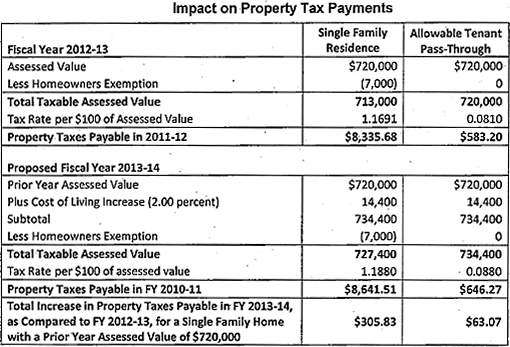The Property Tax rate for the City and County of San Francisco is slated to increase 1.62 percent from $1.1691 per $100 of assessed value in the current Fiscal Year to $1.1880 per $100 of assessed value for Fiscal Year 2013-2014.
The proposed allocation of San Francisco’s property tax dollars is as follows:

Thanks to Proposition 13, the State has once again authorized a maximum allowable increase of 2 percent in assessed value this year for properties that haven’t changed hands or been improved.
The proposed pass-through rate to residential tenants will increase to $0.088 per $100.00 of assessed value for landlords, up from $0.081 in the current fiscal year.

San Francisco’s Board of Supervisors is slated to ratify the new rates this week.
The government employees are very, very hungry.
Meanwhile…Mayor Ed Lee’s $7.9 billion budget proposal is a nearly 10 percent increase over the current year’s budget, or $710 million more.
Sucking the citizenry dry, one or two percent at a time.
“General Stuff”
Gotta love Prop 13, where a billionaire who owns a $10 million home can pay the same 2% as an everyday homeowner who owns a $750k home.
Jim, the travesty isn’t that it’s the same 2%, it’s that they’re potentially paying it on the same base, or lower.
I wonder if on a cost per person basis if San Francisco is the most expensive government in the country? I would rather have them cover the basics such as less crime, streets in better repair. fix MUNI, less trash on streets, less homeless, etc. instead of watching them worry about parklets, park mobiles , “smart ” parking meters and pedestrian bulbs.
SF has got to bring its labor costs under control. If it didn’t spend such exhorbitant sums on pensions, retiree health care, and benefits – not to mention the inefficiencies caused by ridiculous work rules – it could a lot more with a lot less.
AnonFedUp wrote:
> I wonder if on a cost per person basis if
> San Francisco is the most expensive government
> in the country?
San Francisco spends ~$9,500/person
Chicago spends ~$3,100/person
Burlingame spends ~$3,300/person
The amount of money wasted in SF just boggles the mind…
SF also spends more money per capita than NYC, which given the amount of public safety spending there is indeed mind-boggling.
If you ever wonder why BART can’t replace their carpeted cars, or why Muni sucks and doesn’t have a subway to the beach or north end of town, you can thank the public servants that are sucking up all of the resources.
I calculate this as a 1.61% increase in the tax rate, so if you add the 2% increase in value, then that’s a 3.61% tax increase. Not a lot for those folks who’s property has been undervalued for years and years, but for more recent buyers, it’s another big hit. Add to that, all the parcel taxes that have been voted in lately and the newer buyers are screwed while the beneficiaries of Prop 13 are laughing all the way to the bank.
@FormerAptBroker, what is your source? I’m curious to know more.
SF: The worst run big city
The tax dollar is need to allow city employee to retire in their early 50s and receive pension and health care for the rest of their life.
http://www.sfgate.com/bayarea/matier-ross/article/Retiring-S-F-police-brass-cash-in-on-way-out-2460498.php
SF cost per cap in relation to other cities. In your numbers remember that we are a city+county. Not that I justify our tax and spend ways (non-profits that receive lots of tax payer funds with very little benefits testing), but you will need to sort out the “county” portion of the budget as well as enterprise functions (Sheriff county, SF International, Water system …etc).
MrsLotus wrote:
> @FormerAptBroker, what is your source?
> I’m curious to know more.
If you Google a city name and budget you will see that most full budgets are on line and I got the population numbers from Wikipedia.
P.S. I read on a blog today that Davis, CA spends ~$3,700/person
Last I read, the SF had an unfunded pension liability that officially was close to $2B and more realistically was around $5 billion. Plus, the pension spiking and double-dipping have been well documented over the years.
Your tax dollars at work.
Where did you read that grey? I see a research paper by Dr. Joe Nation from Stanford, but he uses the long term gain of 6.2% as a baseline, which is low given that the long term gain, with dividends re-invested, has been over 10%. It might not seem like much, but that 3.8% is huge.
I think that CalPers and SFERS are now using 7.75% (nominal) rates of return, which make sense, given that inflation seems to be so much lower than it was last century.
our local govt stinks way worse than state and the state stinks worse than the national. and the national stinks, so the city govt really stinks